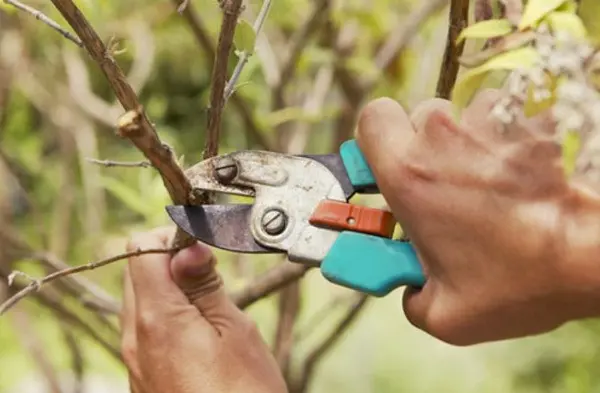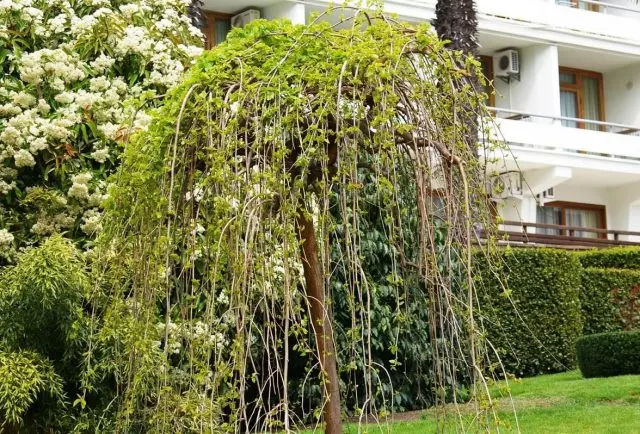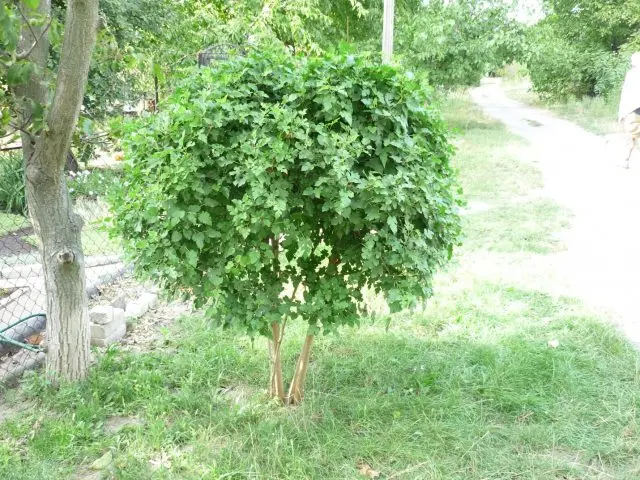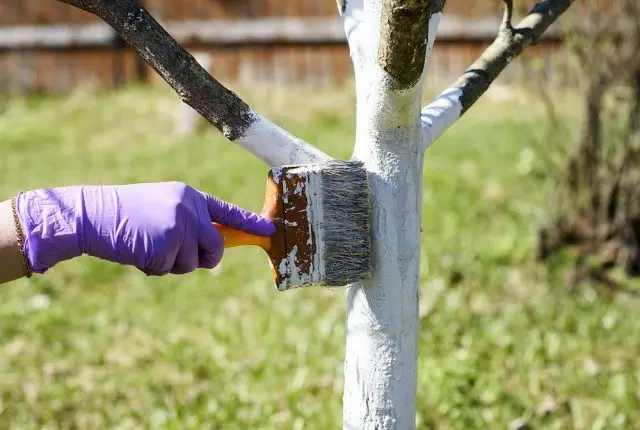Contents
Mulberry is a fairly frequent guest in the gardens of southern Our Country. This tree from year to year gives good harvests of berries, and often without any care. Despite this, many gardeners prefer to cut the mulberry tree. And it is absolutely justified. Mulberry pruning is a very useful event that allows you to beautifully shape a tree, increase its yield and avoid many diseases.
Why is mulberry pruning necessary?
Mulberry trees are grown not only for harvest. They are very decorative, especially varieties with a weeping crown, so gardeners often decorate summer cottages or house adjoining areas with them. And also the green of the mulberry tree is used as a fodder crop for the silkworm. For any of these purposes, pruning will be useful. It helps to maintain the crown in a healthy state, allows you to competently form a tree in a certain way so that it is convenient to work with it in the future.

Pruning gives a powerful impetus to the development of new shoots, enhances lateral branching and the growth of green mass. As a result, the crown is denser, and the tree synthesizes more nutrients through photosynthesis. Timely cutting of old, diseased and damaged branches significantly heals the tree, prevents diseases from developing, and reduces the number of pests. All these measures improve the decorative appearance of mulberry, and also increase its yield.
Features of pruning different types of mulberry
How to prune a mulberry tree depends on its purpose. If it is planted to obtain a crop of berries, it is formed as a fruit tree, laying several fruit-bearing tiers. A tree planted for ornamental purposes is pruned according to its chosen crown shape, maintaining its type and size. Technical trees, the foliage of which serves as food for silkworm caterpillars, are pruned so that branching and the amount of green mass are maximum.
Types of trimming
There are several types of mulberry pruning. All of them are carried out to perform certain tasks and differ from each other. There are the following types of pruning mulberry:
- sanitary;
- rejuvenating;
- formative;
- decorative.
Formative
Formative pruning is done in the first few years after planting a mulberry seedling. During this period, the mulberry is characterized by intensive growth, at this time the foundation of the tree is laid, its skeleton is formed. Mulberries are planted not only to harvest berries. Often it is used in landscape design, as well as for technical purposes, as a food base for breeding silkworms. Depending on this, the mulberry is formed:
- Fruit tree.
- Decorative tree on a trunk with a spherical crown.
- Broom.
- A tree with a weeping crown.
- Bush.

The way the mulberry crown is formed also depends on the region in which the tree grows. The bushy form is more winter-hardy, so this method is widely used in cold regions. Some varieties of mulberry are distinguished by long annual shoots, therefore they have a predisposition to form a tree with a weeping crown.
Rejuvenating
Over time, the yield of mulberries can decrease significantly. You can restore it with anti-aging pruning. This procedure is usually carried out over several years. During this time, old wood is gradually removed, in return for it, new shoots are grown, on which fruiting is transferred. At the same time, dried and broken branches, as well as diseased and affected by pests, are removed. Shoots that thicken and grow deep into the crown, vertical tops and competitors are removed. The interior of the crown is illuminated.
Sanitary
Sanitary pruning of mulberries should be carried out annually at least 2 times per season. This is early spring, when the tree has not yet entered the growing season, as well as autumn, the time after the end of leaf fall. During sanitary pruning, broken, dried and damaged branches are removed, the tree stem is cleaned. Shoots are also removed, on which there are traces of disease damage.
How to properly cut a mulberry tree
In order to cut the mulberry tree correctly and not cause irreparable damage to the tree, certain rules must be observed:
- Trees can only be pruned at certain times of the year.
- For trimming, you must use only high-quality, well-sharpened and disinfected tools. The cuts left by sharp edges heal much better and faster.
- The older the trees, the more severe pruning can be done. Young trees must be pruned carefully, otherwise it can lead to their death.
- Green, non-lignified shoots can be broken out with your hands or pinched off their top, thereby stopping their growth if they are unnecessary or improper growth.
- When removing shoots “on the ring” or pruning on a promising bud or shoot, you must follow the correct technique.

How to prune mulberries in spring
Mulberry spring pruning is done when the threat of big frosts is completely absent, otherwise the cut shoots are guaranteed to freeze. You can start this procedure only after the air temperature is stable above -10 ° C. In the southern regions, mulberry can be cut already in early March, in more northern regions – in April. The exact time of spring pruning is chosen taking into account the climate of the region. It is important to have time to do this procedure before the start of sap flow, then the rehabilitation period for the mulberry will be minimal.
Mulberry pruning in the spring includes all the main types of work. At this time, they do a sanitary cleaning of the tree, form the crown of a young mulberry, and also perform work to rejuvenate old plants.
How to cut a mulberry tree in summer
The summer pruning scheme for mulberries is very simple. Major work at this time, as a rule, is not carried out. The only exception is the trimming of decorative mulberry, the crown of which needs to maintain a constant shape. At this time, only the young growth that goes beyond the dimensions is cut off. At this time, the growth of green non-lignified shoots can be limited if they are planned to be removed in the future. To do this, their top is simply pinched off with a fingernail. This measure allows the plant to direct nutrients to the growth and maturation of berries, and not to excessive shoot formation.
How to prune mulberries in autumn
In autumn, mulberry pruning is usually carried out only for sanitary purposes. The tree is inspected, if necessary, damaged and dried branches are cut out. Particular attention should be paid to the crown if the appearance of diseases or pests was noted on it during the season. Branches affected by fungus or other pathologies are removed, after which they must be collected and burned.
Mulberry formation by years
There are several schemes for shaping mulberry pruning in spring. Depending on the purpose of planting, the tree crown can be formed as follows.
- Crown of a fruit tree. In the first year, the seedling is cut to a height of 1 m. All other shoots are removed completely. In the second year of life, you need to choose from the regrown lateral shoots 3-5 of the strongest, extending from the central conductor at an angle of 45 ° or more, located at a height of 0,7 m from the ground and above. All other shoots must be removed. The central conductor is cut off, leaving 4-5 buds on it above the upper side branch. The lower skeletal branches are cut to a length of 0,3 m, the upper ones must be shortened even more. In the third year, the tree is considered formed.
- Spherical decorative crown. It is formed on a bare trunk at a height of 1-1,5 m. The central conductor is cut off at a height of 2-4 m, depending on the need. Pruning of lateral shoots is carried out by 1/3 in the upper and lower parts of the crown and ¼ in the middle. The main thing is that the crown is uniform in circumference and looks like a ball.
- Decorative “broom”. Very beautiful type of crown. First you need to completely clean the trunk from side shoots to a level of 1-1,5 m from the ground. Then you need to choose 3-5 strong lateral shoots that have a large angle of departure and are located approximately at the same height from the ground. The rest must be removed. The selected branches are cut off by 4 buds. The conductor must be cut at the same level as the upper skeletal branch.
- “Weeping” crown. To form such a crown, it is necessary to grow a tree with a stem to a height of 1,5 m. Each of the shoots growing higher is cut to 4-5 buds, which should be directed outward. Every next spring, all growing annual shoots are also cut to 5-6 buds looking outward.
- This order is maintained until the complete formation of the crown.
- Bush. Mulberry bush formation is used in areas with adverse weather conditions. To form a crown of this type, it is necessary to select 3-5 strong lateral shoots extending from the trunk at a height of 0,15-0,4 m in the first year of the seedling’s life. They are cut into 4-5 buds, all other branches are removed. The central conductor is cut off at the height of the upper skeletal branch.
- In the second year, the procedure must be repeated, choosing another 3-4 shoots. Last year’s shoots are cut by 1/3. In the third year, the bush should consist of 6-8 equivalent trunks. Weak side shoots and improperly growing branches must be cut into a ring.
After the crown is formed in the right way, it is maintained in the right dimensions, cutting off and thinning out the annual growth.
How to form a mulberry in the suburbs
The Moscow region is an atypical area for planting and growing mulberries. The natural area of its growth is located south of the Kursk and Voronezh regions. However, it is quite possible to grow a mulberry tree in the Moscow region and even to the north. To do this, choose white varieties of mulberry, such as Belaya Staromoskovskaya, Admiralskaya or Belaya Medovaya. Their winter hardiness is higher than that of red and black varieties. When landing, the place is very important. It should be open and sunny, but at the same time well protected from the north and east winds.

The best results when growing mulberry in the Moscow region are given by its formation in the form of a low (up to 1,5 m) bush on a very short trunk. This form makes it possible to bend the shoots to the ground for the winter and cover them. Sanitary cleaning is carried out in this region in late April or early May, after the removal of winter shelter. Autumn pruning of mulberry in the Moscow region, as a rule, is not carried out so as not to weaken its winter hardiness.
Plant care after pruning
Mulberry does not require special care, it is a very unpretentious plant. After pruning, it is advisable to only feed the plant a little. In the spring, this can be done by introducing rotted manure, humus, as well as a complex nitrogen-containing fertilizer, for example, nitroammophoska, into the root zone. After autumn pruning, you can add a little superphosphate to the soil. Nitrogen fertilizers are not applied at this time of the year.

Cut branches must be collected and burned, especially after sanitary pruning. Fungus spores, pathogens and insect pests can live in them. After that, the stems of the trees must be whitewashed. Such a measure will prevent excessive heating and cracking of the tree bark under the bright spring sun. Whitewashing is also a good preventive measure against insect pests and their larvae, wintering in cracks and folds of the bark.
Conclusion
Mulberry pruning is a fairly simple procedure that even a beginner can do. However, it is necessary to start it only after studying the theoretical part. And for beginners, it is better for the first time to use the help of more experienced colleagues.









